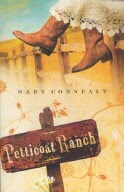Click here for part one
It's easy to muddle internal and external conflict. The external conflict bleeds into the internal conflict and before you know it, it's hard to say which is which.
Here are some examples of external conflict from my own books.
External Conflict
Sophie’s no-account husband taught her the hard way to do everything herself before he was hanged as a horse thief.
Clay grew up in the Rocky Mountains with his fur trapping father and no women anywhere. Idyllic. Now he’s injured and at the mercy of a woman and her four daughters and not a one of them will mind him.
In Petticoat Ranch I've created one of my favorite external conflicts. She’s been surviving with her own strength for years, starting long before her husband died. He’s barely spoken to a woman. All he knows is: The men are supposed to be in charge. She’s heard that too, but what if the orders he gives are stupid?
For the perfect external conflict just remember, whatever he has to have—has to destroy her. They can't both get what they want. It's impossible. Easy.
Internal Conflict
Internal is more complex. It's what shapes your character into a person who won't take a chance on love. There needs to be two of these because each character has his or her own, and those conflicts have nothing to do with each other, except it influences how they deal with each other. It has to do with emotions, fears, old memories, things you can't see that go on inside a person.
A classic example of internal conflict is:
For Her: Her parents died when she was very young. Her fiancé died on their wedding day. Everyone she loves dies, she'll never risk her heart again.
For Him: His first love announced in front of the whole congregation—at their wedding—that she was in love with the best man—no, make it his brother—no, let's make her pregnant by his brother. He'll never risk his heart again.
The Internal conflict in Petticoat Ranch is:
Sophie was married to an arrogant, moody, inept city boy who dragged her off to live his dream on a Texas ranch. She ended up doing all the work then he turned up dead. She liked him okay when he was in a good mood and she missed him some, but really, the ranch ran better without him. Then the banker threw her off the ranch for not having a man around, unless of course she marries him. Her opinion of men just keeps sinking to new depths. Now a new man comes along and wants to help and her expectations are really low.
Clay’s never been around a woman in his life and he’s scared to death of the one he’s ended up stuck with. She cries, she disobeys him, she nags and she doesn’t say what she means. If she doesn’t want him calling her stupid, she ought to just say so. What’s he supposed to do, read her mind?
This is the internal conflict from Petticoat Ranch. She is independent, hard working, competent and she’s learned her lesson about men. When a new man falls into her life by way of plunging off a cliff, she accepts his proposal in a weak moment then sets out to
Note that internal conflict is personal. It's all her pain or his pain. Their shared pain comes from the external conflict. It's not enough to say, "She's untrusting and he's a loner." Why is she untrusting? Did a mere six broken engagements destroy her trust in men so profoundly that she will never risk her heart again? Why is he a loner? Did his years as an assassin warp him to the point he will never risk his heart again, even though the people he killed were all 'bad?'
Continue to part three

 “If they’re sassing each other and falling in love while running for their lives, then I’m happy.”
“If they’re sassing each other and falling in love while running for their lives, then I’m happy.”Mary Connealy writes books that bring humor to the Wild West. Her next book, Calico Canyon, a sequel to Petticoat Ranch, will be released in August, 2008. Mary lives in northeastern Nebraska, is a teacher married to a farmer, and has four beautiful daughters. To learn more about Mary and her books, visit www.MaryConnealy.com
Hi, Camy. I picked this up on my Google Alert notice. :)
ReplyDeleteYou cannot hide from me, don't even TRY!!!!!!!!
Great explanation Mary, Thanks!
ReplyDelete